#azure automation
Explore tagged Tumblr posts
Text
How to Deploy Azure Resources Using Azure Bicep
Azure Bicep In this article, I show you how to deploy Azure resources using Azure Bicep. It is a domain-specific language (DSL) for declaratively deploying Azure resources. It aims to simplify creating and managing your Azure infrastructure by offering several advantages over the traditional method using Azure Resource Manager (ARM) templates. Azure Bicep is used to deploy resources such as…

View On WordPress
#automation#Azure#Azure Automation#Azure Bicep#Azure Resource Manager Template#Azure Storage Account#Azure Subscription#Azure Virtual Machines#Resource Group
0 notes
Text
Unlocking the full Power of Hybrid Runbooks for Azure Automation
In today's rapidly evolving cloud computing landscape, mastering the art of automation is crucial. 'Unlocking the Power of Hybrid Runbooks for Azure Automation' dives deep into how Azure Automation can revolutionize the way you manage and automate cloud.
In the ever-evolving landscape of cloud computing, efficiency, and automation are not just buzzwords but essential strategies for managing complex cloud environments. Azure Automation emerges as a pivotal tool in this realm, offering a robust, cloud-based automation service that helps you focus on work that adds business value. By automating frequent, time-consuming, and error-prone cloud…
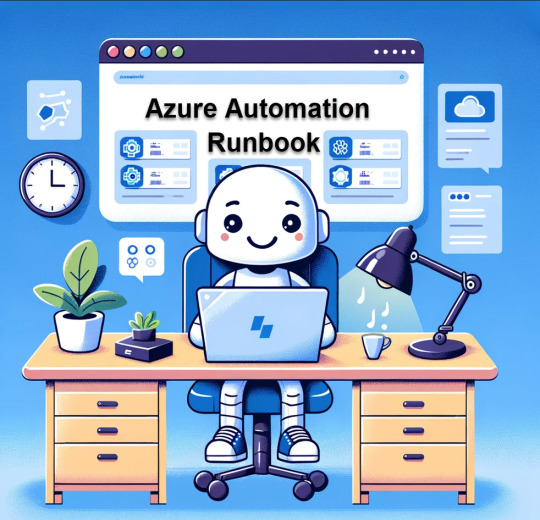
View On WordPress
#Automation Strategies#AzCopy#Azure Automation#Azure services#Azure VM Management#Cloud Computing#Cloud Management#Cloud Security#Data management#Hybrid Runbook Workers#IT Automation#Operational Efficiency#PowerShell Scripting#Virtual Machines
0 notes
Text
[Azure] Pause Resume Fabric, Embedded o AAS con SimplePBI
Hace un poco más de un mes que Fabric llegó y no para de causar revuelo. La posibilidad de una capacidad con todas las características de Premium y más pero al estilo pay as you go como lo es Power Bi Embedded me parece excelente.
En este artículo voy a hablar de la última actualización de la librería de Python SimplePBI que permite Pausar y/o Resumir los recursos de Bi. Si usan Analysis services, PowerBi Embedded o Fabric y les gustaría ahorrar cuando las herramientas no se usan, entonces este código nos ayudará a ejecutar la acción. Luego podemos ver como agregarlo a un schedule en Azure para que se automático.
Pre-Requisitos
Lo primero que necesitas son dos prerequisitos.
1- La versión 0.1.4 de SimplePBI o superior. En esa versión incorporaron la clase azpause que nos ayudará. Para actualizarla pueden usar pip:
pip install simplepbi --upgrade
2- Una App Registrada en Azure con secreto creado para usar como Service Principal. Copiaremos el Tenant Id, Client o App Id y Secret generado.
Ejecución
Para iniciar vamos a ir a nuestro recurso de Azure (Fabric, PBI Embedded o AAS) y daremos permiso en el control de accesos (IAM) al Service Principal (App Registrada) como “Contributor”. Este permiso le dará posibilidad de ejecutar acciones como prendido y apagado. A partir de ese momento seremos libres de ejecutar el sencillo código.
from simplepbi import azpause # Initialize the object authenticating Azure azure = azpause.Azpause(TENANT_ID, client_id, client_secret) # Run method of the object for pause or resume azure.resume_resource(subscriptionId, resourceGroupName, resourceType, resourceName) azure.pause_resource(subscriptionId, resourceGroupName, resourceType, resourceName)
Así de simple con tres líneas. Importar librería, autenticar creando objeto y llamar el método del objeto especificando valores que podemos copiar del “Overview” del recurso:
suscriptionId: el id de la suscripción, no del tenant.
resourceGroupName: nombre del grupo de recursos donde creamos el recurso
resourceType: tipo de recurso, recibe uno de tres valores posibles “FABRIC”, “PBI” o “AAS”
resourceName: nombre del servidor AAS o la capacidad Fabric/Embedded
Enlace al repo con su doc: https://github.com/ladataweb/SimplePBI/blob/main/AzPauseResume.md
Automatizarlo en Azure
Uno de los mejores usos de esa acción es programar la ejecución de dichas líneas conociendo las brechas de tiempo en que no se usan. Para ello podemos hacerlo de manera local con Windows Schedule o en Azure para no depender de una VM. Dentro de Azure hay diversos servicios, podríamos usar por ejemplo Azure Functions. En mi caso voy a mostrar el ejemplo con una cuenta de Automation creando un Runbook.
En el portal de Azure crearemos una cuenta de automatización o en ingles Automation Account. El código que usaremos estará en Python 3.8. Una vez creada la cuenta busquemos la opción Python Packages donde agregaremos la librería:

Para agregar la librería primero descargaremos el archivo Wheel de SimplePBI. Pueden encontrarlo en: https://pypi.org/project/SimplePBI/#files
Con el archivo descargado basta con seleccionar “Add a Python Package” con signo +. Tras añadir el archivo “whl” debería reconocer el nombre y ustedes seleccionen 3.8 en la versión de python
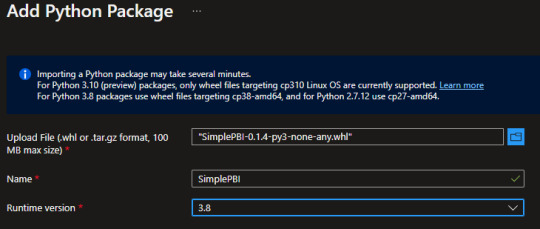
Todo esto es para poder importar simplepbi en el código de nuestro runbook. Luego de cargar la librería, que puede tardar varios minutos, crearemos un runbook en el menú de la izquierda dentro de la cuenta de automatización
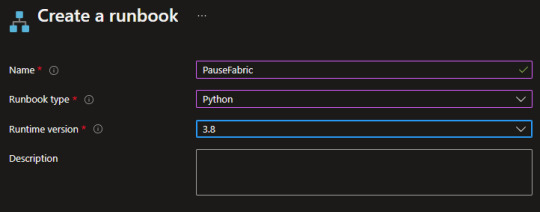
El ejemplo lo haremos con el Pausado. El código sería igual para el Resumir el servicio solo que cambiaría el último método. Creado nos guiará a una interfaz para comenzar a escribir nuestro código Python. Esto sería bastante sencillo. Algo así:
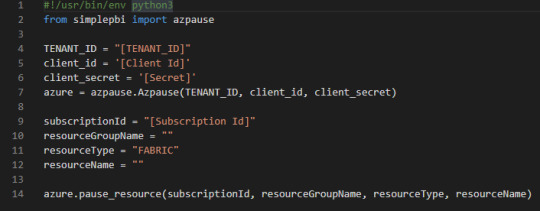
Sin embargo, recordemos que exponer claves en código es una falta de seguridad grave. Entonces lo mejor sería crear un Azure KeyVault para guardar nuestros secretos o IDs y que no queden expuestos. Para ello basta con crear el recurso KeyVault, añadir su cuenta como Key Vault Administrator y crear el secreto. Si quieren conocer más sobre esto pueden buscar ejemplos o seguir el training: https://learn.microsoft.com/en-us/training/modules/configure-and-manage-azure-key-vault/
Si usan KeyVaults se vería así:
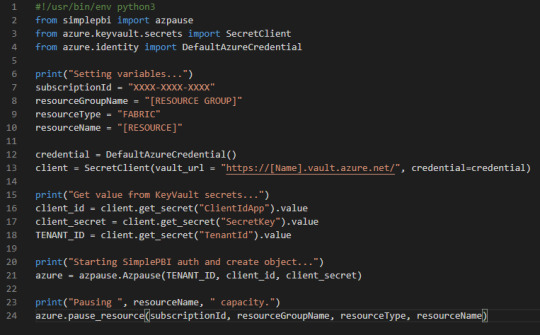
Guardar y publicar. Luego podemos darle play para ver que todo funcione correctamente.
Lo último que haremos será calendarizar la corrida del script. Si ya conocemos el uso del recurso sabremos sus tiempos y horarios. Puede ser que se apague de noche o los fines de semana. Para ello, vamos al runbook y nos fijamos en el menú “Schedule” y seguimos las indicaciones de la imagen:
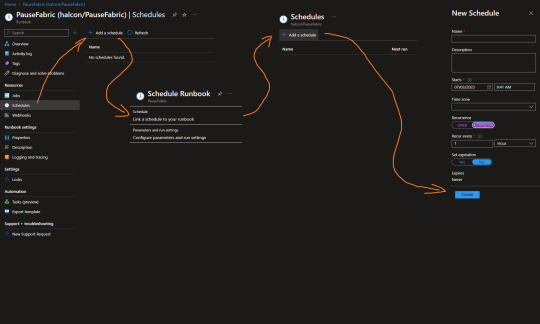
De ese modo podemos configurar corridas recurrentes del código para asegurarnos que todo esté en orden.
Así es como terminamos de construir nuestra Pausa de Fabric, PowerBi Embedded o Azure Analysis Services usan SimplePBI. Seguramente haría falta que repitan el proceso para “Resumir” el recurso de manera que prenda cuando necesiten usarlo.
#azure#azure automation#python#power bi python#microsoft fabric#power bi embedded#azure analysis services#azure tips#azure training#azure tutorial#ladataweb#simplepbi
0 notes
Text
Abathur

At Abathur, we believe technology should empower, not complicate.
Our mission is to provide seamless, scalable, and secure solutions for businesses of all sizes. With a team of experts specializing in various tech domains, we ensure our clients stay ahead in an ever-evolving digital landscape.
Why Choose Us? Expert-Led Innovation – Our team is built on experience and expertise. Security First Approach – Cybersecurity is embedded in all our solutions. Scalable & Future-Proof – We design solutions that grow with you. Client-Centric Focus – Your success is our priority.
#Software Development#Web Development#Mobile App Development#API Integration#Artificial Intelligence#Machine Learning#Predictive Analytics#AI Automation#NLP#Data Analytics#Business Intelligence#Big Data#Cybersecurity#Risk Management#Penetration Testing#Cloud Security#Network Security#Compliance#Networking#IT Support#Cloud Management#AWS#Azure#DevOps#Server Management#Digital Marketing#SEO#Social Media Marketing#Paid Ads#Content Marketing
2 notes
·
View notes
Text
youtube
The Best DevOps Development Team in India | Boost Your Business with Connect Infosoft
Please Like, Share, Subscribe, and Comment to us.
Our experts are pros at making DevOps work seamlessly for businesses big and small. From making things run smoother to saving time with automation, we've got the skills you need. Ready to level up your business?
#connectinfosofttechnologies#connectinfosoft#DevOps#DevOpsDevelopment#DevOpsService#DevOpsTeam#DevOpsSolutions#DevOpsCompany#DevOpsDeveloper#CloudComputing#CloudService#AgileDevOps#ContinuousIntegration#ContinuousDelivery#InfrastructureAsCode#Automation#Containerization#Microservices#CICD#DevSecOps#CloudNative#Kubernetes#Docker#AWS#Azure#GoogleCloud#Serverless#ITOps#TechOps#SoftwareDevelopment
2 notes
·
View notes
Text
Might just start blogging about my silly little gbf teams I love most of them a whole lot
#I’m just really having a good time with gbf now that I’ve gotten the most annoying parts automated#(seriously every beginner guide just glosses over the pro skip function)#all it took was three separate attempts but now that I’m having fun#it really recaptures the magic of what made me play azur lane for so long#(I still love azur lane but it’s lost a little of its sheen now that it’s just dailies with a new ship I can really tism about every#couple months)
2 notes
·
View notes
Text
Azure’s Evolution: What Every IT Pro Should Know About Microsoft’s Cloud
IT professionals need to keep ahead of the curve in the ever changing world of technology today. The cloud has become an integral part of modern IT infrastructure, and one of the leading players in this domain is Microsoft Azure. Azure’s evolution over the years has been nothing short of remarkable, making it essential for IT pros to understand its journey and keep pace with its innovations. In this blog, we’ll take you on a journey through Azure’s transformation, exploring its history, service portfolio, global reach, security measures, and much more. By the end of this article, you’ll have a comprehensive understanding of what every IT pro should know about Microsoft’s cloud platform.
Historical Overview
Azure’s Humble Beginnings
Microsoft Azure was officially launched in February 2010 as “Windows Azure.” It began as a platform-as-a-service (PaaS) offering primarily focused on providing Windows-based cloud services.
The Azure Branding Shift
In 2014, Microsoft rebranded Windows Azure to Microsoft Azure to reflect its broader support for various operating systems, programming languages, and frameworks. This rebranding marked a significant shift in Azure’s identity and capabilities.
Key Milestones
Over the years, Azure has achieved numerous milestones, including the introduction of Azure Virtual Machines, Azure App Service, and the Azure Marketplace. These milestones have expanded its capabilities and made it a go-to choice for businesses of all sizes.
Expanding Service Portfolio
Azure’s service portfolio has grown exponentially since its inception. Today, it offers a vast array of services catering to diverse needs:
Compute Services: Azure provides a range of options, from virtual machines (VMs) to serverless computing with Azure Functions.
Data Services: Azure offers data storage solutions like Azure SQL Database, Cosmos DB, and Azure Data Lake Storage.
AI and Machine Learning: With Azure Machine Learning and Cognitive Services, IT pros can harness the power of AI for their applications.
IoT Solutions: Azure IoT Hub and IoT Central simplify the development and management of IoT solutions.
Azure Regions and Global Reach
Azure boasts an extensive network of data centers spread across the globe. This global presence offers several advantages:
Scalability: IT pros can easily scale their applications by deploying resources in multiple regions.
Redundancy: Azure’s global datacenter presence ensures high availability and data redundancy.
Data Sovereignty: Choosing the right Azure region is crucial for data compliance and sovereignty.
Integration and Hybrid Solutions
Azure’s integration capabilities are a boon for businesses with hybrid cloud needs. Azure Arc, for instance, allows you to manage on-premises, multi-cloud, and edge environments through a unified interface. Azure’s compatibility with other cloud providers simplifies multi-cloud management.
Security and Compliance
Azure has made significant strides in security and compliance. It offers features like Azure Security Center, Azure Active Directory, and extensive compliance certifications. IT pros can leverage these tools to meet stringent security and regulatory requirements.
Azure Marketplace and Third-Party Offerings
Azure Marketplace is a treasure trove of third-party solutions that complement Azure services. IT pros can explore a wide range of offerings, from monitoring tools to cybersecurity solutions, to enhance their Azure deployments.
Azure DevOps and Automation
Automation is key to efficiently managing Azure resources. Azure DevOps services and tools facilitate continuous integration and continuous delivery (CI/CD), ensuring faster and more reliable application deployments.
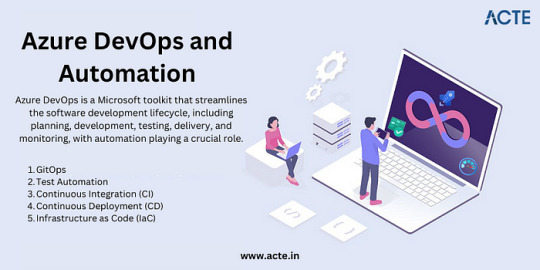
Monitoring and Management
Azure offers robust monitoring and management tools to help IT pros optimize resource usage, troubleshoot issues, and gain insights into their Azure deployments. Best practices for resource management can help reduce costs and improve performance.
Future Trends and Innovations
As the technology landscape continues to evolve, Azure remains at the forefront of innovation. Keep an eye on trends like edge computing and quantum computing, as Azure is likely to play a significant role in these domains.
Training and Certification
To excel in your IT career, consider pursuing Azure certifications. ACTE Institute offers a range of certifications, such as the Microsoft Azure course to validate your expertise in Azure technologies.

In conclusion, Azure’s evolution is a testament to Microsoft’s commitment to cloud innovation. As an IT professional, understanding Azure’s history, service offerings, global reach, security measures, and future trends is paramount. Azure’s versatility and comprehensive toolset make it a top choice for organizations worldwide. By staying informed and adapting to Azure’s evolving landscape, IT pros can remain at the forefront of cloud technology, delivering value to their organizations and clients in an ever-changing digital world. Embrace Azure’s evolution, and empower yourself for a successful future in the cloud.
#microsoft azure#tech#education#cloud services#azure devops#information technology#automation#innovation
2 notes
·
View notes
Text
Cloud Platforms Testing at GQAT Tech: Powering Scalable, Reliable Apps
In today's digital world, most companies use the cloud to host their software, store their data, and provide users with seamless experiences and interactions, meaning their cloud-based systems have to be fast and secure (it could be an e-commerce site, a mobile app, or corporate software platform) and be able to provide a robust reliable level of service that does not fail. All this hard work to develop a cloud-based application means nothing if the application is not subjected to testing and verification to work properly in different cloud environments.
Credit should be given to GQAT Tech for making cloud platform testing a core competency, as the entire QA team tests applications in the cloud, on cloud-based platforms, i.e., AWS, Azure, Google Cloud, or Private Cloud, while testing for performance, security, scalability, and functionality.
Now, let's explore the definition of cloud platform testing, what it is, why it is important, and how GQAT Tech can help your company be successful in the cloud.
What Is Cloud Platform Testing?
Cloud platform testing provides validation of whether a web or mobile application will function correctly in a cloud-based environment (as compared to on a physical server).
It involves testing how well your app runs on services like:
Amazon Web Services (AWS)
Microsoft Azure
Google Cloud Platform (GCP)
IBM Cloud
Private/Hybrid cloud setups
The goal is to ensure your app is:
Scalability - Will it support more users over time with no performance degradation?
Improve security - Is my data protected from being compromised/attacked?
Stability - Is it repeatably functioning (no crashing or errors)?
Speed - Is the load time fast enough for users worldwide?
Cost - Is it utilizing cloud resources efficiently?
GQAT Tech’s Cloud Testing Services
GQAT Tech employs a hybrid process of manual testing, automated scripts, and real cloud environments to validate/applications in the most representative manner. The QA team manages real-time performance, availability, and security across systems.
Services Offered:
Functional Testing on Cloud
Validates that your app will behave in an appropriate way while hosted on different cloud providers.
Performance & Load Testing
Validates how your app behaves when 10, 100, or 10,000 users are accessing it at the same time.
Scalability Testing
Validates whether your app is capable of scaling up or down based on usage.
Security Testing
Validates for vulnerabilities specific to clouds: data leak vulnerabilities, misconfigured access, and DDoS risks.
Disaster Recovery & Backup Validation
Validates whether systems can be restored after failure or downtime.
Cross-Platform Testing
Validates your application's performance across AWS, Azure, GCP, and Private Cloud Systems.
Why Cloud Testing Is Important
By not testing your application in the cloud, you expose yourself to significant risks such as:
App crashes when usage is highest
Data loss because of inadequate backup
Cloud bills that are expensive due to inefficient usage
Security breaches due to weaker settings
Downtime that impacts customer frustration
All of these situations can be prevented and you can ensure your app runs smoothly every day with cloud testing.
Tools Used by GQAT Tech
GQAT Tech uses advanced tools for cloud testing:
Apache JMeter – Load testing and stress testing
Postman – API testing for cloud services
Selenium / Appium – Automated UI testing
K6 & Gatling – Performance testing
AWS/Azure/GCP Test Environments – Real cloud validation
CI/CD Pipelines (Jenkins, GitHub Actions) – Continuous cloud-based testing
Who Needs Cloud Platform Testing?
GQAT Tech works with startups, enterprises, and SaaS providers across industries like:
E-commerce
Healthcare
Banking & FinTech
Logistics & Travel
IoT & Smart Devices
Education & LMS platforms
If your product runs in the cloud, you need to test it in the cloud—and that’s exactly what GQAT does.
Conclusion
Cloud computing provides flexibility, speed, and power—but only if your applications are tested and validated appropriately. With GQAT Tech's cloud platform testing services, you can be confident that your application will work as required under all real-world environments.
They will help eliminate downtime, enhance app performance, protect user data and help optimize cloud expenditure—so you can expand your business without concern.
💬 Ready to test smarter in the cloud? 👉 Explore Cloud Platform Testing Services at GQAT Tech
#Cloud Platform Testing#AWS Testing#Azure Testing#Google Cloud QA#Cloud Application Testing#Performance Testing on Cloud#Cloud Scalability Testing#Functional Testing on Cloud#Cloud Security Testing#Cloud-Based QA#GQAT Cloud Services#CI/CD in Cloud#Real-Time Cloud Testing#Cloud QA Automation#SaaS Testing Platforms
0 notes
Text
🚫 Stop Saying: "DevOps = Development + Operations"
✅ Start Understanding: DevOps is a Culture, Not Just a Combination
DevOps isn't just about merging two departments; it's a methodology that fosters collaboration, automation, and continuous improvement across the software development lifecycle.
Dive deeper into DevOps methodologies and learn how to implement them effectively in your organization.
📌 Follow us for ❤️ @nareshitech
#DevOpsCulture#ContinuousIntegration#Automation#SoftwareDevelopment#TechInnovation#devops#aws#cloudcomputing#linux#python#cloud#technology#programming#developer#coding#kubernetes#devopsengineer#azure#cybersecurity#software#java#datascience#docker#javascript#softwaredeveloper#css#machinelearning#devopstools#jenkins
1 note
·
View note
Text
Mastering Dynamics 365 Migration: Strategies for a Seamless Transition
Migrating to Microsoft Dynamics 365 is a strategic move for organizations aiming to modernize their business operations and enhance agility. As a modular, cloud-based platform, Dynamics 365 connects core business functions from sales and customer service to finance, supply chain, and HR. Its flexibility allows organizations to deploy only the functionality they need, reducing complexity and cost.
Key Considerations for a Successful Dynamics 365 Migration:
Data Assessment and Cleansing: Before initiating the migration, it’s crucial to evaluate the quality and relevance of existing data. This involves identifying redundant or obsolete information and ensuring that the data aligns with the structure and requirements of Dynamics 365.
Mapping and Transformation: Establish clear mappings between source data fields and the corresponding fields in Dynamics 365. This step ensures that data is accurately transformed and loaded into the new system, maintaining data integrity and consistency.
Incremental Migration Approach: Instead of a “big bang” migration, consider an incremental approach. This method allows for testing and validation at each stage, reducing the risk of disruptions and ensuring a smoother transition.
Testing and Validation: Conduct thorough testing to validate the accuracy and completeness of migrated data. This includes system integration testing and user acceptance testing to ensure that the new system meets business requirements.
Stakeholder Engagement: Engage key stakeholders throughout the migration process. Their insights and feedback are invaluable for identifying potential issues and ensuring that the new system aligns with organizational goals.
VBeyond Digital’s Expertise in Dynamics 365 Migration:
VBeyond Digital specializes in providing comprehensive Dynamics 365 migration services. With a team of experienced professionals, they offer end-to-end support, from initial assessment and planning to execution and post-migration support. Their approach ensures minimal disruption to business operations and maximizes the benefits of transitioning to Dynamics 365.
By leveraging VBeyond Digital’s expertise, organizations can navigate the complexities of Dynamics 365 migration with confidence, ensuring a seamless and successful transition.
For more information on how VBeyond Digital can assist with your Dynamics 365 migration, visit their website.
0 notes
Video
youtube
Terraform on Azure - Standard LoadBalancer with Meta Argument Count | In...
#youtube#Learn how to automate Azure infrastructure using Terraform by configuring a Standard Load Balancer (SLB) with the count meta-argument for sc
0 notes
Text

Are you looking for Cloud Partner who can assist you with Cloud migration, infrastructure Monitoring, Cloud Cost Optimisation and architecture design?
At techjour, an advanced Cloud Partner, we provide these benefits at no additional csot - ensuring you maximise the value of your Cloud investment.
Lets discuss, how you can leverage these advantage by partnering with us.
#technology#startup#automation#trendingnow#cloud service provider#cloudcomputing#cloud services#google cloud#aws cloud#microsoft azure#cloudmigration#cloud mining#cloud infrastructure#usa news#technology news
0 notes
Text
📌 FREE DevOps with Multi-Cloud Training! 🌍
📅 Starts: 7th April 2025 | 🕢 7:30 AM IST 🎯 Learn AWS, Azure, Google Cloud & CI/CD Automation
🔗 Register for Free: https://tr.ee/ZizWRU 🔗 Upcoming Batches: https://linktr.ee/NIT_Training
📢 Tag a friend who needs this!

0 notes
Text
Selenium Training with Certification: Become a Test Automation Expert
In today’s fast-paced software development world, automation testing has become a vital component of the software lifecycle. Selenium is one of the most popular and widely used frameworks for automating web applications, enabling businesses to speed up testing processes, reduce human error, and ensure software quality. For those looking to enhance their career in software testing, enrolling in a Selenium Training course can be a game-changer. This guide will provide detailed insights into why Selenium is an essential skill, what to expect from Selenium certification training, and how becoming a Selenium expert can propel your career forward.
Introduction: Why Selenium is the Future of Automation Testing
The demand for automation in software testing has increased dramatically. Selenium stands out as one of the most powerful open-source tools available today, with its ability to automate web browsers across different platforms and programming languages. Whether you're looking to pursue a career as a Test Automation Engineer, Quality Analyst, or Selenium Developer, mastering Selenium is an investment in your future.
With its growing adoption in industries like e-commerce, banking, healthcare, and more, the need for professionals who understand Selenium automation testing is at an all-time high. Selenium certification offers tangible proof of your skills and can make your resume stand out in a competitive job market.
What is Selenium and Why Should You Learn It?
Selenium is an open-source tool that provides a suite of software designed for automating web browsers. It supports multiple programming languages, including Java, Python, C#, Ruby, and JavaScript, allowing testers to write tests in the language they are most comfortable with.
Benefits of Selenium Automation Testing
Cross-browser Testing: Selenium supports various browsers such as Chrome, Firefox, and Safari, ensuring your applications perform consistently across different platforms.
Support for Multiple Programming Languages: Unlike many other testing tools, Selenium allows testers to write scripts in different programming languages, making it flexible for developers from various backgrounds.
Open-source and Free: Since Selenium is open-source, it significantly reduces the cost of testing and provides businesses with a cost-effective solution.
Scalability: Selenium can handle large-scale test suites and is easily integrated with other tools like Jenkins, Docker, and TestNG, allowing for continuous integration and continuous delivery (CI/CD).
By becoming proficient in Selenium testing, you gain a highly sought-after skill that boosts your career prospects in the software development and quality assurance sectors.
What to Expect from a Selenium Training Course
A comprehensive Selenium course online can equip you with the knowledge and skills needed to become an expert in Selenium automation. Here’s what you can expect from a Selenium certification course:
1. Introduction to Selenium
The course will begin with a solid introduction to the Selenium framework, its components, and how it integrates into the software development lifecycle. You'll learn about:
Selenium WebDriver
Selenium IDE (Integrated Development Environment)
Selenium Grid for parallel execution
2. Writing Basic Selenium Scripts
You'll start writing basic automation scripts using Selenium WebDriver. This involves understanding the core concepts such as locating web elements using locators (ID, class name, XPath, CSS selectors) and interacting with them (clicking buttons, entering text, etc.).
3. Advanced Selenium Techniques
As you progress, you will dive into advanced topics like:
Handling dynamic web elements
Automating forms and data-driven tests
Working with different browsers and platforms using Selenium Grid
Implementing synchronization techniques to manage waiting conditions in tests
4. Integrating Selenium with Other Tools
A strong emphasis will be placed on integrating Selenium with other tools for improved test automation. You'll learn how to use frameworks like TestNG or JUnit for test execution, and how to integrate Selenium with Jenkins for continuous integration (CI). You’ll also explore how to work with tools like Maven and Ant for managing dependencies.
5. Reporting and Test Execution Management
You'll also learn how to generate test reports, track test results, and manage test execution in real-time using third-party libraries like ExtentReports.
Hands-On Learning: Real-World Applications
Selenium is all about practice. The best way to master it is through hands-on projects and real-world examples. A Selenium course training will guide you through practical scenarios where you can automate the testing of real websites and web applications.
For example, you might be tasked with writing a script that logs into a demo e-commerce site, searches for a product, adds it to the cart, and checks out. These exercises help you apply your knowledge to actual web automation tasks, making the learning process more engaging and relevant.
How Selenium Certification Can Benefit Your Career
A Selenium certification serves as proof of your expertise in test automation and enhances your credibility as a skilled professional in the field. Here’s how it can benefit you:
Better Career Opportunities: Selenium skills are in high demand across industries. Having a certification makes you an attractive candidate for roles like Test Automation Engineer, QA Engineer, and more.
Increased Earning Potential: Certified professionals typically earn more than their non-certified counterparts. With the rise of automation in software testing, Selenium-certified individuals can command higher salaries.
Industry Recognition: A certification from a recognized training provider serves as an official acknowledgment of your skills and knowledge, which is respected by employers globally.
Up-to-Date with Industry Standards: The certification ensures you’re up-to-date with the latest trends and best practices in test automation, keeping you competitive in the fast-evolving tech industry.
How to Get Certified in Selenium?
To earn your Selenium certification, you must complete a training program that offers a comprehensive curriculum and hands-on experience. Here are the steps:
Choose the Right Selenium Training Course: Look for a course that covers all aspects of Selenium, from basics to advanced topics. Ensure that it includes practical exercises, quizzes, and projects to test your skills.
Complete the Course: Dedicate time to learn the material thoroughly. Engage with the content and practice writing test scripts.
Take the Certification Exam: After completing the course, you’ll likely need to take a certification exam. This will test your understanding of Selenium concepts and your ability to apply them in real-world scenarios.
Earn Your Certification: Once you pass the exam, you’ll receive your Selenium certification, proving your expertise and enhancing your career prospects.
Conclusion: Start Your Selenium Journey Today
Selenium is an essential tool for anyone pursuing a career in test automation. It not only saves time and resources but also ensures higher accuracy in testing. Enrolling in a Selenium course training and obtaining Selenium certification can propel your career, offering you hands-on skills, industry knowledge, and credibility.
By mastering Selenium, you position yourself as an expert in the field of selenium automation testing and selenium software testing, making you an asset to any organization.
Key Takeaways
Selenium is a powerful tool for automating web applications and a must-have skill for test automation professionals.
A Selenium certification course equips you with the practical skills required to excel in software testing.
Earning Selenium certification boosts your career prospects, making you more competitive in the job market.
Start your learning journey today, and unlock opportunities in the booming field of automation testing!
#Selenium Training#Selenium Training online#Selenium certification#Selenium certification training#Selenium certification course#Selenium course#Selenium course online#Selenium course training#selenium automation testing#selenium software testing#azure devops training
0 notes
Text
Magistral: Mistral AI challenges big tech with reasoning model
New Post has been published on https://thedigitalinsider.com/magistral-mistral-ai-challenges-big-tech-with-reasoning-model/
Magistral: Mistral AI challenges big tech with reasoning model
Mistral AI has pulled back the curtain on Magistral, their first model specifically built for reasoning tasks.
Magistral arrives in two flavours: a 24B parameter open-source version called Magistral Small that anyone can tinker with, and a beefier enterprise edition, Magistral Medium, aimed at commercial applications where advanced reasoning capabilities matter most.
“The best human thinking isn’t linear—it weaves through logic, insight, uncertainty, and discovery,” explains Mistral AI.
That’s a fair point, existing models often struggle with the messy, non-linear way humans actually think through problems. I’ve tested numerous reasoning models and they typically suffer from three key limitations: they lack depth in specialised domains, their thinking process is frustratingly opaque, and they perform inconsistently across different languages.
Mistral AI’s real-world reasoning for professionals
For professionals who’ve been hesitant to trust AI with complex tasks, Magistral might change some minds.
Legal eagles, finance folks, healthcare professionals and government workers will appreciate the model’s ability to show its work. All conclusions can be traced back through logical steps—crucial when you’re operating in regulated environments where “because the AI said so” simply doesn’t cut it.
Software developers haven’t been forgotten either. Magistral claims to shine at the kind of structured thinking that makes for better project planning, architecture design, and data engineering. Having struggled with some models that produce plausible-sounding but flawed technical solutions, I’m keen to see if Magistral’s reasoning capabilities deliver on this front.
Mistral claims their reasoning model excels at creative tasks too. The company reports that Magistral is “an excellent creative companion” for writing and storytelling, capable of producing both coherent narratives and – when called for – more experimental content. This versatility suggests we’re moving beyond the era of having separate models for creative versus logical tasks.
What separates Magistral from the rest?
What separates Magistral from run-of-the-mill language models is transparency. Rather than simply spitting out answers from a black box, it reveals its thinking process in a way users can follow and verify.
This matters enormously in professional contexts. A lawyer doesn’t just want a contract clause suggestion; they need to understand the legal reasoning behind it. A doctor can’t blindly trust a diagnostic suggestion without seeing the clinical logic. By making its reasoning traceable, Magistral could help bridge the trust gap that’s held back AI adoption in high-stakes fields.
Having spoken with non-English AI developers, I’ve heard consistent frustration about how reasoning capabilities drop off dramatically outside English. Magistral appears to tackle this head-on with robust multilingual support, allowing professionals to reason in their preferred language without performance penalties.
This isn’t just about convenience; it’s about equity and access. As countries increasingly implement AI regulations requiring localised solutions, tools that reason effectively across languages will have a significant advantage over English-centric competitors.
[embedded content]
Getting your hands on Magistral
For those wanting to experiment, Magistral Small is available now under the Apache 2.0 licence via Hugging Face. Those interested in the more powerful Medium version can test a preview through Mistral’s Le Chat interface or via their API platform.
[embedded content]
Enterprise users looking for deployment options can find Magistral Medium on Amazon SageMaker, with IBM WatsonX, Azure, and Google Cloud Marketplace implementations coming soon.
As the initial excitement around general-purpose chatbots begins to wane, the market is hungry for specialised AI tools that excel at specific professional tasks. By focusing on transparent reasoning for domain experts, Mistral has carved out a potentially valuable niche.
Founded just last year by alumni from DeepMind and Meta AI, Mistral has moved at breakneck speed to establish itself as Europe’s AI champion. They’ve consistently punched above their weight, creating models that compete with offerings from companies many times their size.
As organisations increasingly demand AI that can explain itself – particularly in Europe where the AI Act will require transparency – Magistral’s focus on showing its reasoning process feels particularly timely.
(Image by Stephane)
See also: Tackling hallucinations: MIT spinout teaches AI to admit when it’s clueless
Want to learn more about AI and big data from industry leaders? Check out AI & Big Data Expo taking place in Amsterdam, California, and London. The comprehensive event is co-located with other leading events including Intelligent Automation Conference, BlockX, Digital Transformation Week, and Cyber Security & Cloud Expo.
Explore other upcoming enterprise technology events and webinars powered by TechForge here.
#adoption#ai#ai & big data expo#ai act#AI adoption#ai tools#Amazon#amp#Apache#API#applications#architecture#Artificial Intelligence#automation#azure#Big Data#BIG TECH#black box#box#bridge#california#change#chatbots#clinical#Cloud#Companies#comprehensive#conference#content#cyber
0 notes
Text

🚀 Unlock the full potential of DevOps with Azure Managed Services! From automated deployments to enhanced security and cost savings, Azure helps businesses streamline operations and accelerate growth. Learn how Azure Managed Services can transform your IT infrastructure and drive efficiency.
0 notes